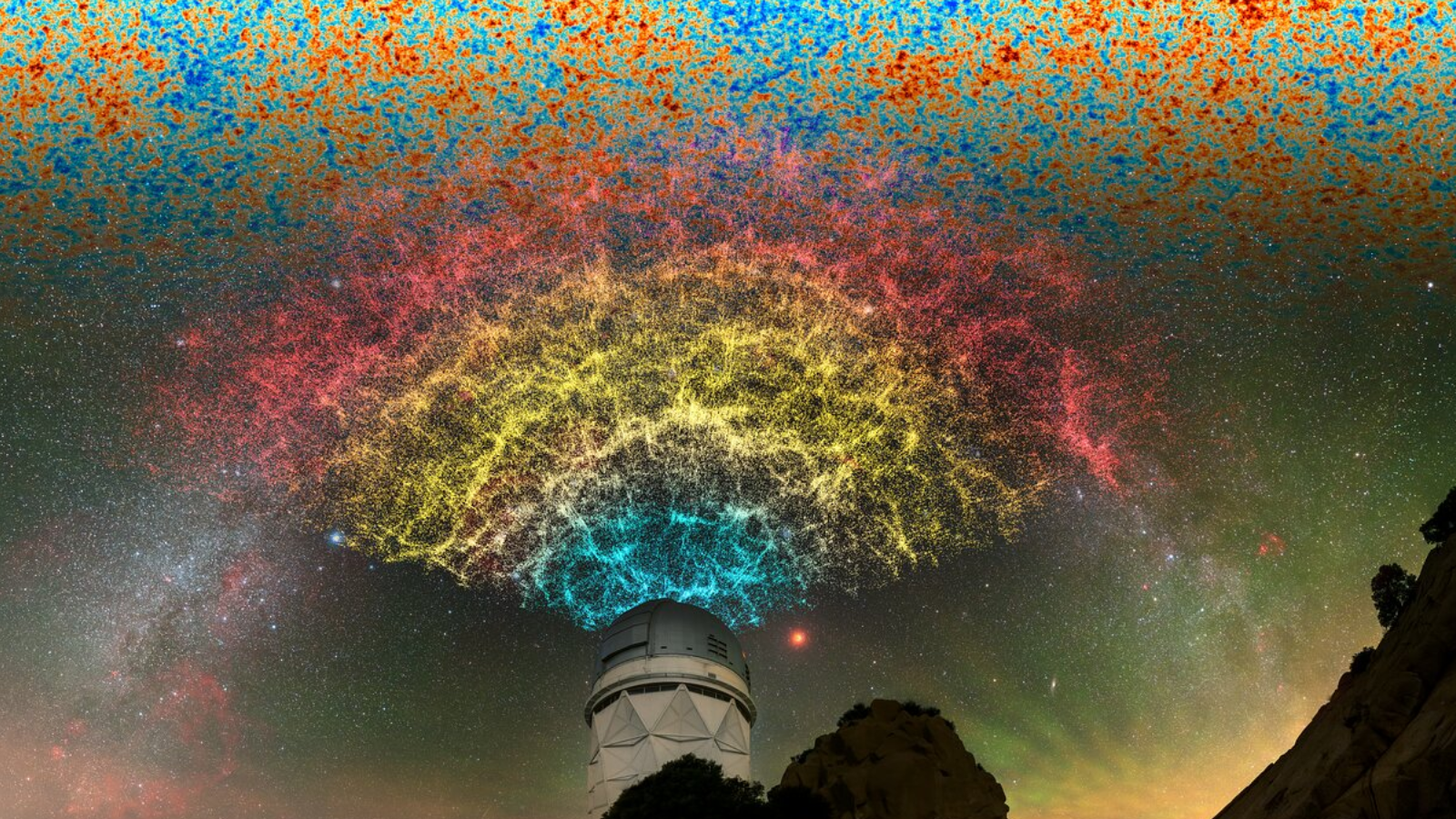
General relativity has passed one of its most precise tests ever thanks to observations of the past 11 billion years of cosmic evolution collected by the Dark Energy Spectroscopic Instrument, or DESI.
Albert Einstein's 1915 theory, general relativity, has remained humanity's best description of gravity for the past 100 years. Cosmologists have used general relativity to model how the cosmos has evolved — from its earliest moments to its current state — and shown how gravity brought together tiny clumps of matter to form vast galaxies as well as clusters of those galaxies. Yet, while general relativity has passed every test applied to it on relatively small scales, few tests have challenged it on very large scales.
Scientists have now performed one such large-scale test by using DESI. They observed almost 6 million galaxies and quasars, which are bright hearts of galaxies powered by feeding supermassive black holes. Perhaps unsurprisingly, this test, which has traced the evolution of the universe since it was around 3 billion years old, has once again shown general relativity to be the right "recipe" for gravity.
"General relativity has been very well tested at the scale of solar systems, but we also needed to test that our assumption works at much larger scales," study co-leader and the French National Center for Scientific Research (CNRS) cosmologist Pauline Zarrouk said in a statement. "Studying the rate at which galaxies formed lets us directly test our theories and, so far, we're lining up with what general relativity predicts at cosmological scales."
Mounted on Kitt Peak National Observatory's Nicholas U. Mayall 4-meter Telescope, DESI is a state-of-the-art instrument composed of 5,000 "robotic eyes." The experiment is now in the fourth year of its five-year sky surveying project, which will eventually see it observe roughly 40 million galaxies and quasars.
Th sky-survey data could be essential for understanding dark energy and dark matter, the mysterious substance that outweighs particles of "everyday matter" that compose stars, planets, moons and everything we see around us on a day-to-day basis, but remains effectively invisible. Collectively described as the "dark universe," dark energy and dark matter suggests that everything we understand in the cosmos accounts for just 5% of its contents.

"Dark matter makes up about a quarter of the universe, and dark energy makes up another 70 percent, and we don’t really know what either one is," team member Mark Maus, a PhD student at Berkeley Lab and UC Berkeley, said in the statement. "The idea that we can take pictures of the universe and tackle these big, fundamental questions is mind-blowing."
Weighing cosmic ghosts
General relativity may be the best description of gravity we have, but it can't explain every single element of the universe that we currently observe, particularly the accelerating expansion of space and the gravitational effect of dark matter. The acceleration of space's expansion is currently attributed to a "placeholder" force called dark energy, which escapes description by cosmological models founded on general relativity.
This failure to account for dark energy has led some scientists to posit alternatives to general relativity that are based on adjustments to Isaac Newton's theory of gravity, which Einstein's magnum opus theory superseded. These theories are generally referred to as "modified theories of gravity," and they explain observations of the universe without the need to introduce an unknown, like dark energy.
In addition to helping to validate the leading model of the universe based on general relativity, the Lambda Cold Dark Matter (LCDM) model, the DESI findings have also helped to rule out some theories of modified gravity.

Additionally, the same results from DESI have helped to place an upper limit on the mass of so-called "ghost particles," or neutrinos.
Neutrinos get their reputation as the phantoms of the particle zoo because of their lack of electric charge and the fact they are virtually massless. As you read this sentence, trillions of these particles have streamed through your body at near-light speed, remaining undetected.
Neutrinos are the only fundamental particles we have discovered whose masses have not been precisely defined by scientists. While previous experiments defined neutrinos' lower mass, the DESI results set an upper limit, giving researchers a more well-defined mass range within which neutrinos should dwell.

The new results come from an extended analysis of the first year of DESI data, released in April 2024. This data formed the largest 3D map of the universe created to date. These results were already remarkable because they seemed to show that the strength of dark energy is changing over time.
The April DESI results focused on a factor of galaxy clustering called baryon acoustic oscillations (BAO) oscillations in matter density that allow large-scale structures to grow. This new examination of these results included what researchers call a "full shape analysis," which further examined how galaxies and matter are distributed on different scales throughout space.
Further results from the second and third years of DESI operations are expected to be released in Spring 2025.
"Both our BAO results and the full-shape analysis are spectacular," research co-leader Dragan Huterer from the University of Michigan said in the statement. "This is the first time that DESI has looked at the growth of cosmic structure. We're showing a tremendous new ability to probe modified gravity and improve constraints on models of dark energy. And it's only the tip of the iceberg."
The DESI results are described in several papers which were published on the research repository site arXiv on Tuesday (Nov. 19).





!["[T]he First and Fifth Amendments Require ICE to Provide Information About the Whereabouts of a Detained Person"](https://images.inkl.com/s3/publisher/cover/212/reason-cover.png?w=600)

